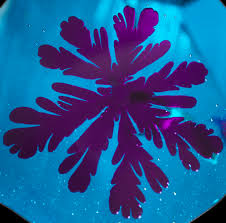Description:
Hele-Shaw fingering occurs when one introduces a low viscous fluid (water)
into a thin plate filled with a high viscous fluid (glycerin) through a small hole, see
this video.
The outcome of such an experiment exhibits pointy fingers, hence the name, see also the figure (A) below.
phase transition, random growth models, DLA, IDLA, Sandpiles, BA, random walks.
Basic knowledge of stochastic processes and martingales is desirable, which can be picked up according to the requirement of the project.
This type of phenomenon reveals a morphological unstable interface and a multiplicity of solutions to an a priori symmetrical problem. How is a particular solution obtained? What is the relationship of the macroscopic smooth differential equation with the underlying microscopic phenomena? How do particles moving in a somewhat random manner produce these unique patterns?
These interesting questions can be analysed using probablistic methods on self-organising random models, such as,

(A) Hele-Shaw fingering.

(B) Border aggregation on the unit disk in \(\mathbb{Z}^2\).
Keywords:
Prerequisites:
Resources: